 I was pleasantly surprised by the condition of the lathe crates when UPS dropped them off. Only one splintered protective board, one slightly suspicious hole through the top right side and no damage to the goods inside. Our local Sunnyvale UPS damage rate was running a consistent 70%, 7 out of 10 packages were crushed, maimed, empty of contents or lost for good. Complaints didn’t help, until we began to refuse all UPS shipments and the local office assigned another driver. From that day, through to the receipt of the lathe, not another problem occurred with a delivery. In this case, the lathe was in transit from New Jersey to California for 5 days. The supplier, Micro-Mark, shipped the day of order receipt.
I was pleasantly surprised by the condition of the lathe crates when UPS dropped them off. Only one splintered protective board, one slightly suspicious hole through the top right side and no damage to the goods inside. Our local Sunnyvale UPS damage rate was running a consistent 70%, 7 out of 10 packages were crushed, maimed, empty of contents or lost for good. Complaints didn’t help, until we began to refuse all UPS shipments and the local office assigned another driver. From that day, through to the receipt of the lathe, not another problem occurred with a delivery. In this case, the lathe was in transit from New Jersey to California for 5 days. The supplier, Micro-Mark, shipped the day of order receipt.
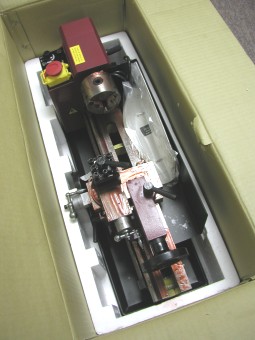 The lathe was nested in Styrofoam, accessories were packed in a plastic bag that was tucked into a formed pocket in the lid. All of the unpainted metal parts were covered in bright red anti corrosive glop, remnants of the machines initial trip over the ocean from China to the United States.
The lathe was nested in Styrofoam, accessories were packed in a plastic bag that was tucked into a formed pocket in the lid. All of the unpainted metal parts were covered in bright red anti corrosive glop, remnants of the machines initial trip over the ocean from China to the United States.
A little care was needed to remove the unit from the carton. It was bolted to a wood sled, and the covers are all “metal look alike” plastic that, if grabbed, won’t support the weight of the lathe. The documentation provided a bill of materials check list, a brief explanation of operation and a schematic of the lathe’s electronics.
All in all, it is as I imagined it would be when I placed the order; a decent small machine that is about perfect for its intended purpose. About half an hour and a pan or two of kerosene later, the lathe was on the bench and running.
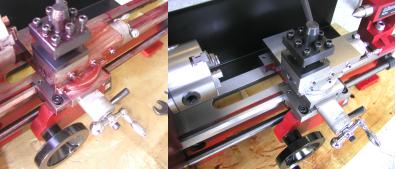 Here’s a little before and after to give you an idea of how the machine cleaned up. I was careful to remove and disassemble some components for cleaning such as the tail stock and tool holder. I was careful not to wash lubricant out from where it was suppose to be, and careful not to start up a dry machine. The break in process was to run at full speed for 5 minutes, the equipment isn’t very loud, and there were no clunks, clanks or parts that fell off during this process. All of the indicators are in English or Imperial units of measure, which is consistent with anything I would design or produce. Small things mean a lot, and this was an important feature of this model lathe.
Here’s a little before and after to give you an idea of how the machine cleaned up. I was careful to remove and disassemble some components for cleaning such as the tail stock and tool holder. I was careful not to wash lubricant out from where it was suppose to be, and careful not to start up a dry machine. The break in process was to run at full speed for 5 minutes, the equipment isn’t very loud, and there were no clunks, clanks or parts that fell off during this process. All of the indicators are in English or Imperial units of measure, which is consistent with anything I would design or produce. Small things mean a lot, and this was an important feature of this model lathe.
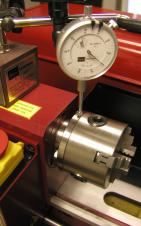 The lathe proved to be relatively trouble free, parts remained tight, and I’m now familiarizing myself with it’s operation while learning to set up different types of jobs. I did take a few moments to put a dial indicator on the chuck, the flange that mounts the chuck and the face of the chuck. The needle on a .001″ graduated indicator barely moved, when it moved at all.
The lathe proved to be relatively trouble free, parts remained tight, and I’m now familiarizing myself with it’s operation while learning to set up different types of jobs. I did take a few moments to put a dial indicator on the chuck, the flange that mounts the chuck and the face of the chuck. The needle on a .001″ graduated indicator barely moved, when it moved at all.
With everything up and running, I’m pleased with the purchase and with Micro-Mark. In retrospect, the only item I probably would not have purchased was the lathe dog, which I believe is too small in diameter for the work I’ll be doing. It’s difficult to get a sense of scale from web image, and this was one of those times. All of the other accessories were as anticipated and all should see routine service.
Mini Mill Arrival
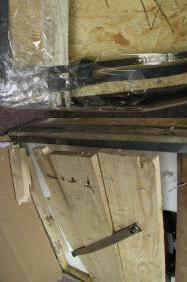 The mini milling machine didn’t fare as well as the lathe, unfortunately, and UPS returned to its normal substandard level of local service. First UPS claimed they had lost the shipment and didn’t know if the crate was in the warehouse, or on a truck; first sign of BS as UPS tracks every move of every package on their systems. We’ve come to learn that a reported lost local package means damaged goods, and that UPS haven’t yet decided to return the freight or deliver the goods broken. Two days later the crate miraculously reappeared, bottom blown out, clear tape holding the loose parts in and two different types of strapping over broken boards. I cut the tape and moved the cardboard off the bottom, only to find the boards had ripped lose from the frame. There were missing pieces of board, a bent metal retaining bar and a pile of broken Styrofoam. The driver offered no warning of the damage, and UPS did not sticker the crate as broken and resealed by UPS.
The mini milling machine didn’t fare as well as the lathe, unfortunately, and UPS returned to its normal substandard level of local service. First UPS claimed they had lost the shipment and didn’t know if the crate was in the warehouse, or on a truck; first sign of BS as UPS tracks every move of every package on their systems. We’ve come to learn that a reported lost local package means damaged goods, and that UPS haven’t yet decided to return the freight or deliver the goods broken. Two days later the crate miraculously reappeared, bottom blown out, clear tape holding the loose parts in and two different types of strapping over broken boards. I cut the tape and moved the cardboard off the bottom, only to find the boards had ripped lose from the frame. There were missing pieces of board, a bent metal retaining bar and a pile of broken Styrofoam. The driver offered no warning of the damage, and UPS did not sticker the crate as broken and resealed by UPS.
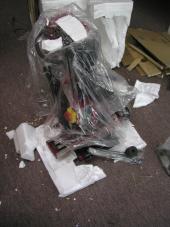 Things didn’t get any better when the outer crate shell was removed. At least half the molded Styrofoam clamshell that held the machine in place was missing, the rest was broken into large and small pieces. The front clear plastic safety shield was snapped into three pieces. All of the tools and small parts that are part of the milling machine assembly; chuck keys, wheel knobs, mount hardware, etc. were loose inside the crate. This means that someone in a supervisory capacity at UPS was aware of the damage to the equipment, knew it was thrown into a case and taped up, but didn’t have even the decency to tell the customer. An inventory of the machine and parts, and verification with Micro Mark, indicated every thing was there, with the exception of the broken shield. I called Micro Mark, and they immediately shipped a replacement.
Things didn’t get any better when the outer crate shell was removed. At least half the molded Styrofoam clamshell that held the machine in place was missing, the rest was broken into large and small pieces. The front clear plastic safety shield was snapped into three pieces. All of the tools and small parts that are part of the milling machine assembly; chuck keys, wheel knobs, mount hardware, etc. were loose inside the crate. This means that someone in a supervisory capacity at UPS was aware of the damage to the equipment, knew it was thrown into a case and taped up, but didn’t have even the decency to tell the customer. An inventory of the machine and parts, and verification with Micro Mark, indicated every thing was there, with the exception of the broken shield. I called Micro Mark, and they immediately shipped a replacement.
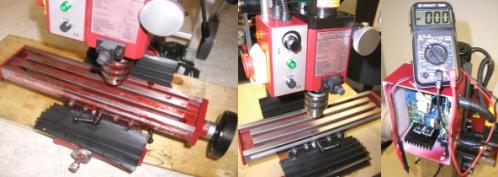 The milling machine was dipped in the same protective grease, only maybe a little more so than the lathe. It cleaned up quickly, same kerosene treatment, and I cranked it over for the same high speed break in. I noticed there was a bit of a chuck wobble, but I couldn’t tell if this was at the outside collar, or the center of the jaws, so I thought I’d wait until the break in was completed and then hang a dial indicator in it. Unfortunately, I didn’t get that far as the machine quit running after a few minutes. There is an overload circuit that is suppose to trip before the break blows, a condition signified by an orange warning light right above the safety stop switch. Then, switching the speed control dial to the off position, then on again, is suppose to reset the circuit. In this instance, the circuit would not reset. A quick check of the motor and motor controller indicated a blown component on the controller board, and a call to Micro Mark put a new controller board in transit. Nice folks and very courteous.
The milling machine was dipped in the same protective grease, only maybe a little more so than the lathe. It cleaned up quickly, same kerosene treatment, and I cranked it over for the same high speed break in. I noticed there was a bit of a chuck wobble, but I couldn’t tell if this was at the outside collar, or the center of the jaws, so I thought I’d wait until the break in was completed and then hang a dial indicator in it. Unfortunately, I didn’t get that far as the machine quit running after a few minutes. There is an overload circuit that is suppose to trip before the break blows, a condition signified by an orange warning light right above the safety stop switch. Then, switching the speed control dial to the off position, then on again, is suppose to reset the circuit. In this instance, the circuit would not reset. A quick check of the motor and motor controller indicated a blown component on the controller board, and a call to Micro Mark put a new controller board in transit. Nice folks and very courteous.
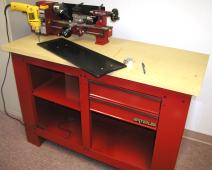 Even though I had this problem with the milling machine, I’m not really concerned, and I know both pieces will work out well in my current shop setting. Rather than getting a dedicated lathe bench, I picked up a $150 Waterloo work bench from Home Depot. Made out of simple stamped and rolled steel, with a 1.5″ thick composite board top, it is very steady and stable under the weight of both machines. In addition, it gave me storage for mill and lathe tools, as well as for 30 or so reloading die sets, and some of the other small bench machines I have in the work area.
Even though I had this problem with the milling machine, I’m not really concerned, and I know both pieces will work out well in my current shop setting. Rather than getting a dedicated lathe bench, I picked up a $150 Waterloo work bench from Home Depot. Made out of simple stamped and rolled steel, with a 1.5″ thick composite board top, it is very steady and stable under the weight of both machines. In addition, it gave me storage for mill and lathe tools, as well as for 30 or so reloading die sets, and some of the other small bench machines I have in the work area.
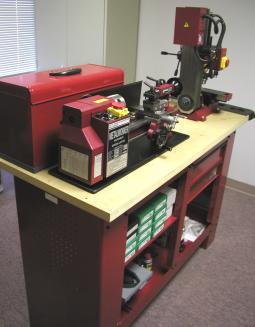 I ran out of wall space and couldn’t figure out how to get everything to fit, then I realized I had this big empty space in the center of the room. I put the bench in the middle, which left plenty of room around it for me to get to everything else. I’m going to mount a small bench top drill press and a grinder on the back side of the bench, which will make a nice self contained work area.
I ran out of wall space and couldn’t figure out how to get everything to fit, then I realized I had this big empty space in the center of the room. I put the bench in the middle, which left plenty of room around it for me to get to everything else. I’m going to mount a small bench top drill press and a grinder on the back side of the bench, which will make a nice self contained work area.
There are still some small tools I need to pick up, and some items designed for securing work to the milling machine table. I’m finding a lot of inexpensive sources for these as well as for some passable precision measuring tools.
No more machine stories until I’ve made something useful, and something worth sharing …..Promise.
Thanks
Joe

Email Notification